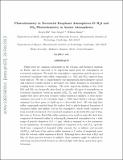PHOTOCHEMISTRY IN TERRESTRIAL EXOPLANET ATMOSPHERES. II. H₂S AND SO₂ PHOTOCHEMISTRY IN ANOXIC ATMOSPHERES
Author(s)
Hu, Renyu; Seager, Sara; Bains, William
DownloadSeager_Photochemistry II.pdf (685.4Kb)
OPEN_ACCESS_POLICY
Open Access Policy
Creative Commons Attribution-Noncommercial-Share Alike
Terms of use
Metadata
Show full item recordAbstract
Sulfur gases are common components in the volcanic and biological emission on Earth, and are expected to be important input gases for atmospheres on terrestrial exoplanets. We study the atmospheric composition and the spectra of terrestrial exoplanets with sulfur compounds (i.e., H₂S and SO₂) emitted from their surfaces. We use a comprehensive one-dimensional photochemistry model and radiative transfer model to investigate the sulfur chemistry in atmospheres ranging from reducing to oxidizing. The most important finding is that both H₂S and SO₂ are chemically short-lived in virtually all types of atmospheres on terrestrial exoplanets, based on models of H₂, N₂, and CO₂ atmospheres. This implies that direct detection of surface sulfur emission is unlikely, as their surface emission rates need to be extremely high (>1000 times Earth's volcanic sulfur emission) for these gases to build up to a detectable level. We also find that sulfur compounds emitted from the surface lead to photochemical formation of elemental sulfur and sulfuric acid in the atmosphere, which would condense to form aerosols if saturated. For terrestrial exoplanets in the habitable zone of Sun-like stars or M stars, Earth-like sulfur emission rates result in optically thick haze composed of elemental sulfur in reducing H₂-dominated atmospheres for a wide range of particle diameters (0.1-1 μm), which is assumed as a free parameter in our simulations. In oxidized atmospheres composed of N₂ and CO₂, optically thick haze, composed of elemental sulfur aerosols (S₈) or sulfuric acid aerosols (H₂SO₄), will form if the surface sulfur emission is two orders of magnitude more than the volcanic sulfur emission of Earth. Although direct detection of H₂S and SO₂ by their spectral features is unlikely, their emission might be inferred by observing aerosol-related features in reflected light with future generation space telescopes.
Date issued
2013-05Department
Massachusetts Institute of Technology. Department of Earth, Atmospheric, and Planetary Sciences; Massachusetts Institute of Technology. Department of PhysicsJournal
Astrophysical Journal
Publisher
Institute of Physics Publishing
Citation
Hu, Renyu, Sara Seager, and William Bains. “ PHOTOCHEMISTRY IN TERRESTRIAL EXOPLANET ATMOSPHERES. II. H₂S AND SO₂ PHOTOCHEMISTRY IN ANOXIC ATMOSPHERES.” The Astrophysical Journal 769, no. 1 (May 20, 2013): 6.
Version: Author's final manuscript
ISSN
0004-637X
1538-4357